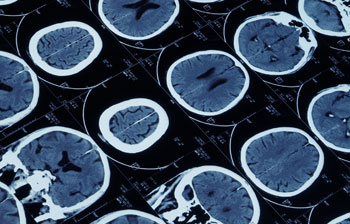| Posted: May 1, 2009 |
A safer nanocolloid contrast agent for magnetic resonance imaging |
|
(Nanowerk News) US and UK scientists have discovered a safer contrast agent for magnetic resonance imaging (MRI). The agent is an alternative to commonly used, but potentially harmful, gadolinium-based agents (Sensitive and efficient detection of thrombus with fibrin-specific manganese nanocolloids – free access article).
|
 |
| MRI can identify blood clots in the brain
|
|
MRI uses paramagnetic metals (contrast agents) to produce high resolution, non-invasive images of the body's internal structure. It is particularly useful in cardiovascular research for visualising blood clots in arteries, which can cause heart attacks and strokes. Although scientists normally use gadolinium as the contrast agent, its recent association with a serious tissue disorder in patients with kidney failure has prompted the development of new, safer imaging agents.
|
|
Dipanjan Pan, at Washington University School of Medicine, St Louis, US, and colleagues stirred manganese oxide nanoparticles in a vegetable oil and surfactant mixture to form manganese oxide nanocolloids with phospholipid shells. They showed that the nanocolloids are highly sensitive to fibrin, a major component of blood clots, and so are effective contrast agents.
|
|
|
|
The colloids can be easily metabolised and excreted by the human body, explains Pan, unlike other manganese-based contrast agents, which are difficult to eliminate and create a hazardous tissue residue. 'Bigger metal crystals are not metabolised and they are typically too large to be excreted through the kidney or bile, presenting an issue for long-term safety. We incorporate tiny manganese oxides or organically soluble chelated manganese into a stable nanoparticle, which is constrained within the vasculature [blood vessels]. This inherent difference over non-excretable nanocrystals should greatly improve the prospects of safety and clinical translation.'
|
|
Taeghwan Hyeon, an expert in nanocrystalline materials at Seoul National University, Korea, agrees. '[These colloidal nanoparticles] can overcome the biosafety issues of other nanoparticle-based MRI contrast agents. Future in vivo applications of these colloidal nanoparticle-based MRI contrast agents are highly anticipated. '
|
|
Pan's group is currently working to prove the efficiency and safety of the imaging agents in vivo, in collaboration with Gregory Lanza at the Consortium for Translational Research in Advanced Imaging and Nanomedicine, St Louis, US.
|

